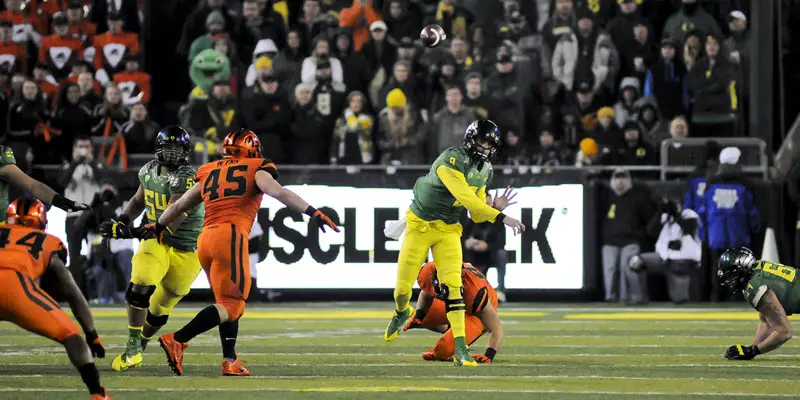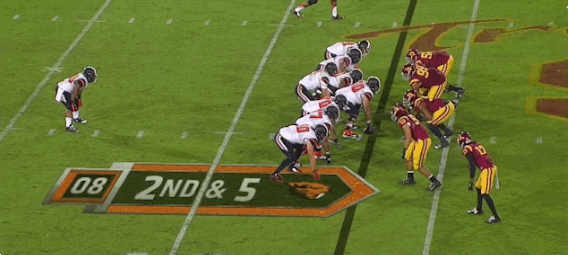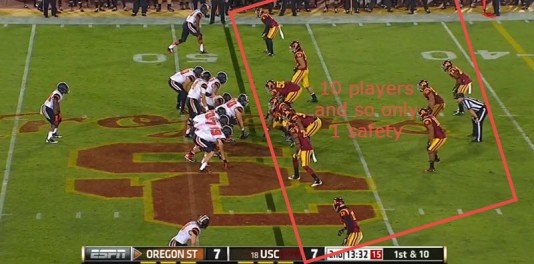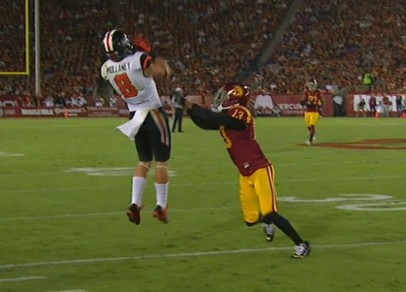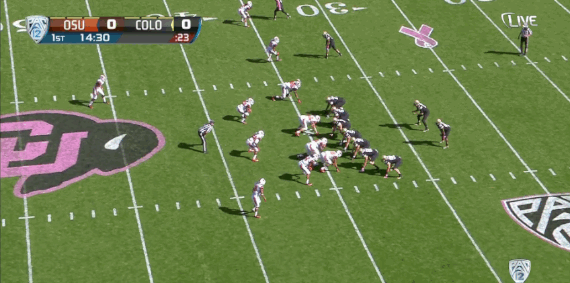There’s a new flavor in the air. It’s the acquired taste for a College Football Playoff berth. Now, as delicious as this new flavor is, let’s not get carried away. Although Duck fans may have forks and knives in hand at the ready, we haven’t been served quite yet. This is a rivalry game, and not just any rivalry game … it’s the Civil War! Anything can happen.
Yes, the Beavers are at the bottom of the Pac-12 North, but did you see the #6 Arizona State Sun Devils go into Corvallis two short weeks ago, only to see their College Football Playoff hopes dashed?
Let’s not forget, the Beavers still have the Pac-12 all-time passing yards leader, Sean Mannion, and two dynamic backs, Terron Ward and Storm Woods. If this was any other team, I’d probably say that this would be an easy win for Oregon, but as previously stated, it’s the Civil War. Anything can happen.
Let’s begin by looking at the classic stretch play by Oregon State. Oregon State runs a traditional pro-style offense, so expect a lot of two tight-end sets (above). Because of the even line for Oregon State, Mannion is not giving away where the play is going to go.
At the snap, the offensive line is going to reach block and the left tackle is going to pull. The tackle is going to employ the “seeing color” technique and block whomever he sees first. Most often, this player is going to be an outside linebacker or a safety. To help create the hole for the running back, the tackle is blocking his man out toward the sideline or back toward the inside — whatever he is able to do most easily.
The key to this play is the running back’s patience and vision. If the running back plays this properly, it should look like the screenshot above. One of Oregon State’s dynamic backs is going to cut it upfield when he finds a hole he likes, in this case right in-between the tight end and the pulling tackle.
The pass play I am going to show you is not complicated at all; in fact, it’s quite the opposite. It’s a deep pass to a tall Beaver receiver. There are two reasons, though, why this play is so effective, especially when playing the Ducks. As you can see (above), this is the same formation as the stretch play, except instead of the two receivers overloaded on one side, there’s one on either side. This is key because the stretch play was the play before this one.
The successful stretch play leads to the Trojans running with only a single high safety. This gives Mannion the green light to throw the jump ball to Richard Mullaney (#8), the receiver wide right. Mannion takes a quick three-step drop and lobs it up to Mullaney … for a big gain.
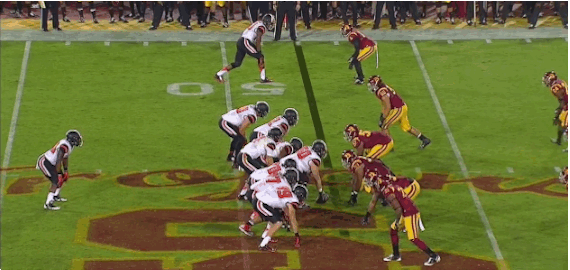
The lob pass can be a very lethal play if you have a receiver like Mullaney and a smart quarterback like Mannion
This is not an “every down” play. It is, though, a great play against a team with shorter defensive backs, like Oregon has. Mullaney is 6’3 and amazing at both high-pointing the ball and getting it over the smaller defensive backs. The Ducks are going to have to look out for this as Ifo Expre-Olomu and Troy Hill are 5’10 and 5’11, respectively, and OSU ran this play successfully on a 6’1 USC defensive back.
It could be a very long game for the Ducks if the game plan doesn’t involve double-teaming star Beaver lineman, Dylan Wynn, or running away from him (or anything else, for that matter), because Wynn is most likely going to be matched up against a backup center, Hamani Stevens or Doug Brenner. To begin, OSU is most likely going to run a 4-2-5 or a 3-3-5 with a pass rushing linebacker. A small, yet major, component to this play is the fact that the left defensive end is lined up way outside the right offensive tackle; I will explain the significance in a second.
At the snap, the left defensive end is going to force the running back back inside because he won’t be able to get blocked properly given the fact that he lined up so far outside. Everyone else is just rushing straight ahead, taking as many double teams as possible in order to leave the linebackers free to make the play.
In this case, Colorado thought that its center could handle Wynn one-on-one. Boy, were they wrong. As you can see from the GIF below and the screenshot above, Wynn just throws off the block and blows up the play for no gain or a loss of one.
With the loss of Hronis Grassu three weeks ago, don’t be surprised if you see short throws by Mariota in the place of deep throws. This could include wide receiver screens, swing passes to Freeman or Tyner, and plenty more. Also, look for Mark Helfrich to run the ball away from Wynn, as he is a force to be reckoned with.
With this said, Oregon can’t do what Arizona State did a few weeks ago: Get complacent and let OSU tally 498 yards of offense. Oregon has experienced a letdown every time it gets close to the national title. This team has already worked hard, though, and I’d like to think that I’ll be in Dallas on January 12th for all the right reasons. I’m going to say Oregon goes into Corvallis and blows them out of the water 59-28.
“Oh, how we love to learn about our opponents on FishDuck.com.”
Rory Davidson
Opponent Football Analyst for CFFNetwork/FishDuck.com
Eugene, Oregon
Top photo by Craig Strobeck
Related Articles:
Chip Kelly Update: Everything's Good Again ...
Chip Kelly Update: Wailing and Gnashing of Teeth
Shock and Awe -- The Oregon Ducks' Football Hangover Effect
Despite Lopsided Score, Georgia State "Never Stopped Believing"
Hope Springs Eternal for Ducks
Incompetent Pac-12 Officials: How Do You Miss ALL of THIS?
Rory Davidson: Rory (Football Analyst) is a sophomore at Oregon in the fall (Class of 2018). He has been a devout Stanford football fan since he was 2 months old and is excited about the energy and greatness Oregon sports has to offer. For the past 6 years he has been doing advanced data analytics for his high school football team and working alongside the coaches to understand how they strategize about the game. He wants to integrate more statistics into his analyses and try to help readers learn about and understand the future of sports.

